Hanging flower baskets can add a beautiful splash of colour to any outdoor space, whether it’s a balcony, patio or garden. Not only do they look beautiful, but they are also easy to create with some basic supplies and tools. Read on for everything you need to know about how to make hanging flower baskets…
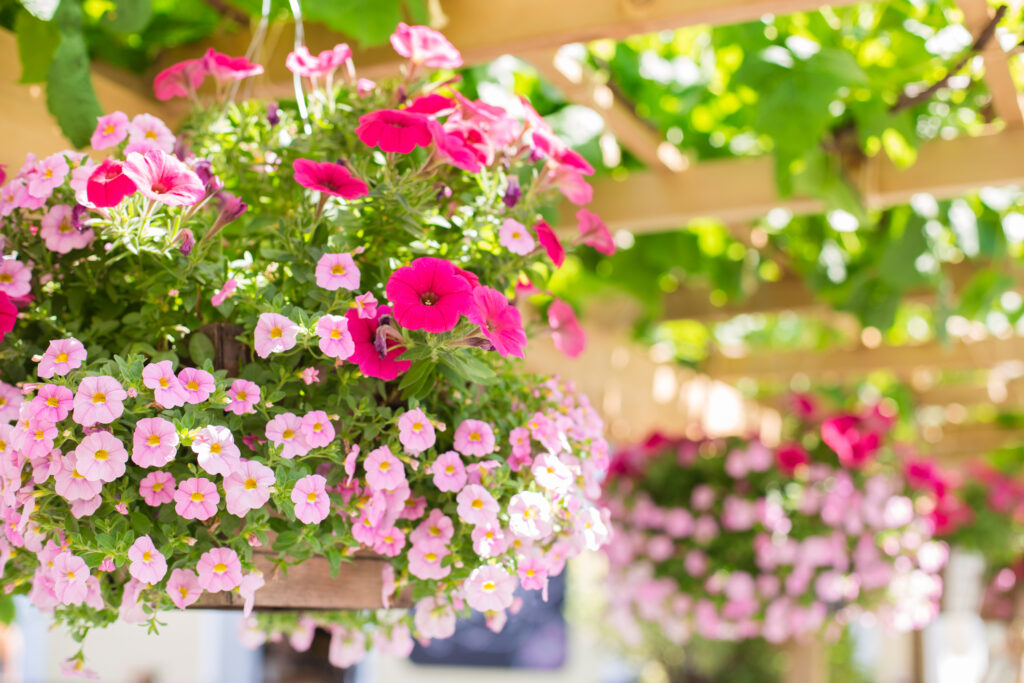
Gather Your Supplies
Start by gathering the supplies you’ll need for your project. This is what you’ll need…
A Hanging Basket
There’s a variety of hanging baskets available, so choose the one that best suits your project.
Hanging plastic containers are cheap and lightweight but can dry out quickly, so you may need to water them more often.
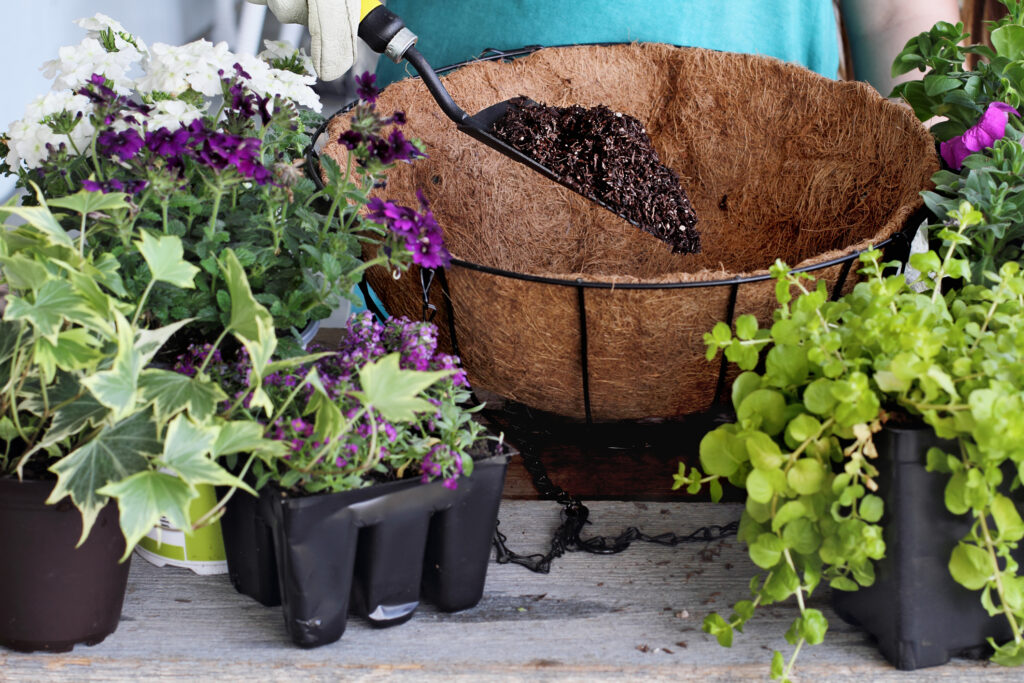
Wicker or metal baskets are usually heavier and more durable but you’ll need to line the bottom with the right material to hold everything in.
Coconut fibre (sometimes called ‘coir’) and wire-bottomed baskets are a great choice as they provide excellent drainage and are easy to maintain.
Soil / Potting Mix
Your soil must be light and airy so that it drains properly and allows plant roots to grow freely. The best option is to buy a purpose-made potting mix, as this will be lightweight and hold on to water and nutrients well.
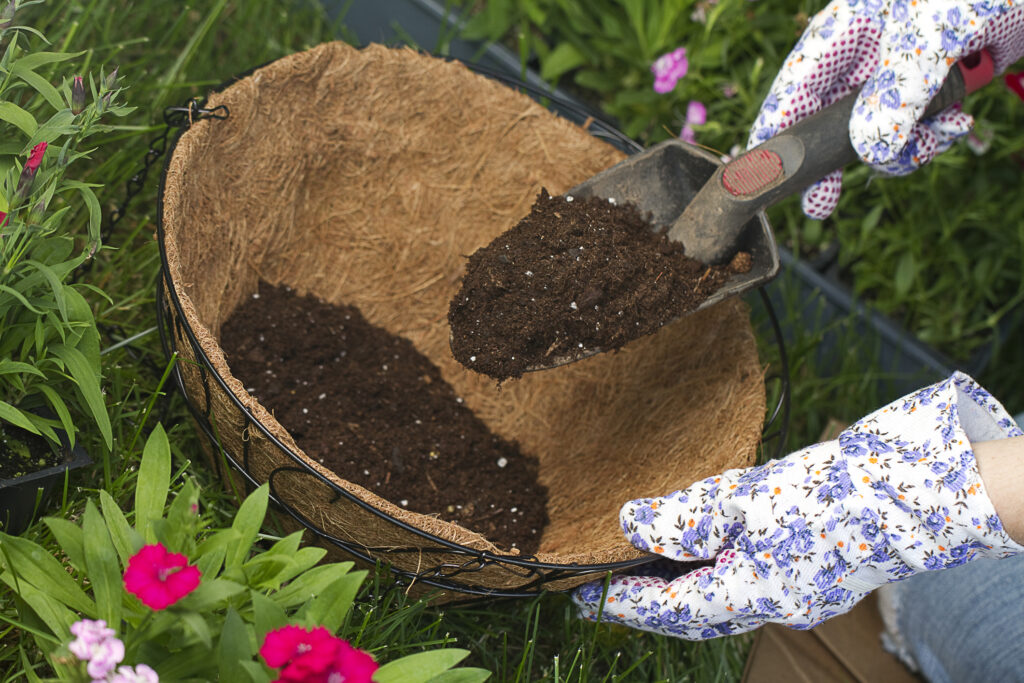
Adding some compost to the potting mix is often a good idea. This will naturally add nutrients to the soil, to help keep your plants healthy and blooming.
Fertiliser (plant food)
As well as soil, you’ll need some plant food to keep your flowers in good condition. Choose a slow-release fertiliser so that it lasts for a few weeks and will provide your plants with the right nutrition.
Some String, Wire or Chain for Suspension
The string or wire should be strong enough to take the weight of the basket and whatever soil and plants you put in it. Thick jute twine or galvanised wire works well for this, but you can also use a cotton cord if the basket is lightweight.
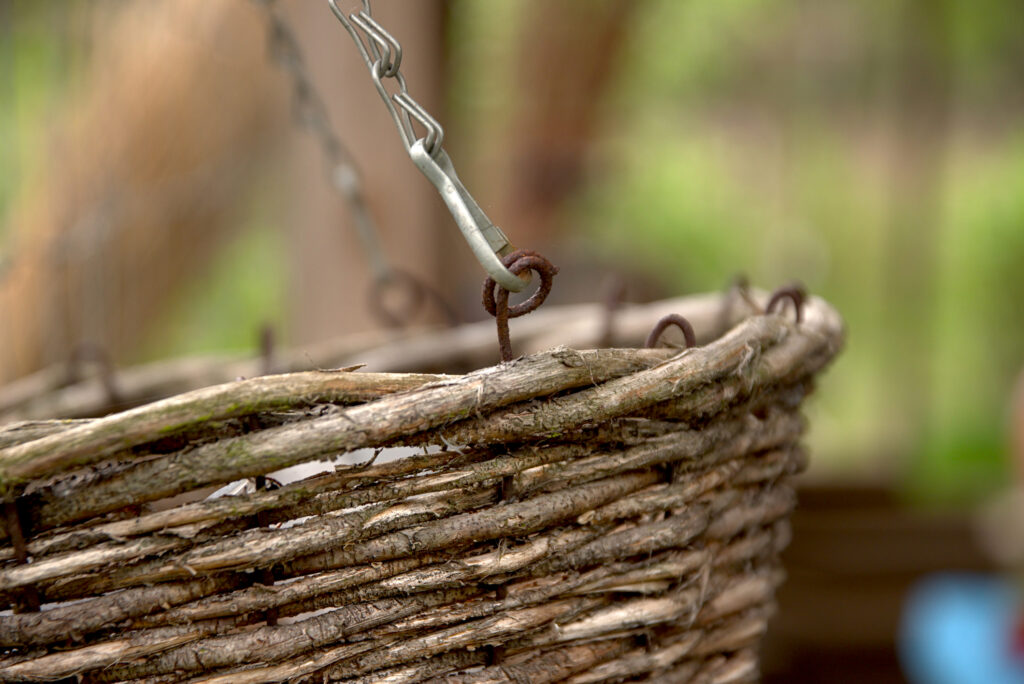
Many pre-made wire hanging baskets come with a lightweight metal chain and hook, which also gives an attractive, classic look.
Plants of Your Choice
When it comes to choosing what to plant in your hanging basket, there are almost limitless options. So many indeed, that we’ll cover some planting ideas for hanging baskets in another post.
To keep things simple for now, just think about what you want to achieve with your display and where it will be located. Consider the following questions…
- What are your favourite colours?
- What other colours are already in the location?
- Do you have a colour scheme in mind?
- Are you keeping to a particular theme? (e.g. traditional/rustic/exotic/modern etc…)
- Do you want flowers with a strong fragrance?
- Would you like to create a wildlife-friendly flower basket? (e.g. for bees and other pollinators to enjoy)
- Will you use a variety of flowers or fill with just one or two types?
- Will you use upright or trailing flowers and plants?
- What greenery could you add to compliment the flowers?
- How big is your basket – what will realistically fit?
- Will your basket be in full sun or shade?
- Could you choose low-maintenance, drought-resistant plants?
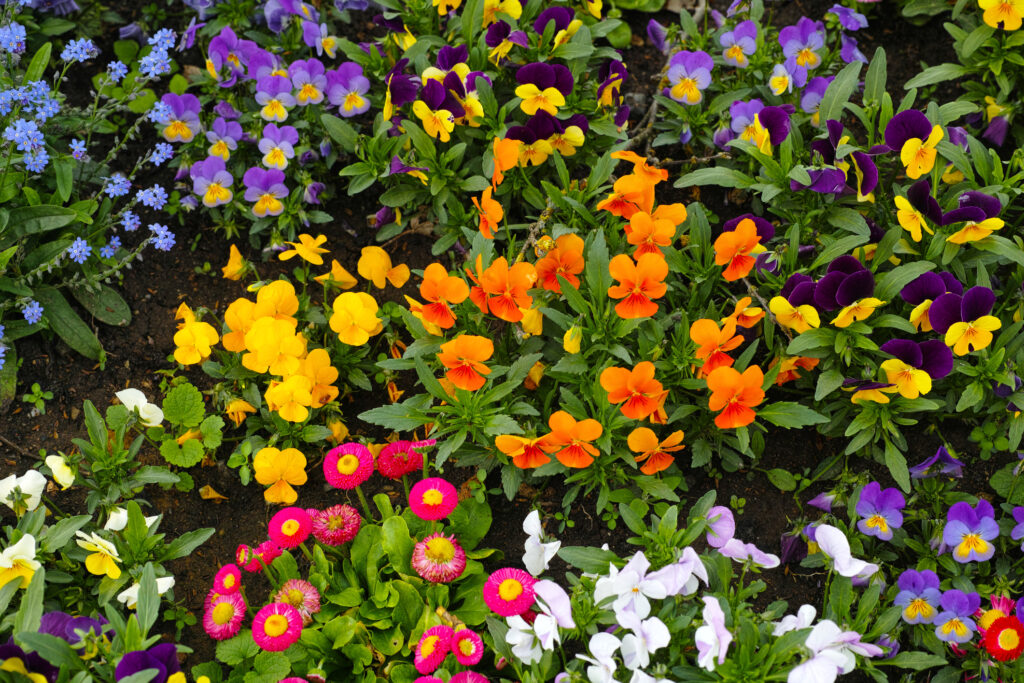
Of course, the plants that you choose will need to be suitable for your chosen location. This usually means plants that are on the smaller side, with a shallow root system. Trailing plants also work well, as they can freely cascade over the sides.
Some popular flower varieties for hanging flower baskets include the following:
- Petunias
- Ivy Geraniums
- Fuchsias
- Lobelias
- Lantanas
- Begonias
- Verbena
- Impatiens
- Marigolds
- Begonias
- Pansies
- Geraniums
- Nastursiums
- Sweet alyssum
Once you’ve gathered your supplies and picked out your plants, you can begin assembling your flower basket. Read on for the step-by-step instructions….
Method: Make A Hanging Flower Basket
Step 1: Preparing Your Basket
Make sure that your basket is clean and free from dust and dirt. If it’s made from wicker or metal, use a brush to remove any cobwebs and debris before lining the bottom to keep soil and dirt in. If you don’t have any coir or fibre matting to use as lining, there are other options, such as newspaper or plastic sheeting.
Step 2: Filling The Basket
Begin by filling the bottom of the basket with your potting mix until it’s about two-thirds full. For extra drainage, you could also add a layer of small stones or gravel to the bottom.
If you’re using soil or a potting mix without compost, then you might wish to add some slow-release fertiliser at this stage for nutrition.
Step 3: Planting
Now it’s time to start planting your flowers and any greenery you wish to add. Start by removing all of the plants from their containers and gently loosening their roots so they can spread out naturally in their new environment.
Place each one in its designated spot in the basket and press down lightly on the surrounding soil until each plant is secure in its new home. Place the larger plants in first, then fill in the gaps with smaller varieties and greenery.
When planting up baskets you’ll probably squeeze in more plants than you normally would, in a flower bed for example. Planting up your basket with a generous number of plants will give it that rich, overflowing look of colour and abundance.
A good rule of thumb is to aim for one plant per inch diameter of the basket. So if for example, your basket is 12 inches across, then you’d start with 12 plants and see how it looks.
If you need to top up the basket will a little extra potting mix, then this is fine but be sure to leave a 2cm gap at the top of the basket. If it’s full to the very top with soil, then you might find that water runs off over the sides.
Step 4: Watering
Once you’ve finished planting your basket, water it thoroughly. Make sure that each plant is given a good soaking to help them settle into its new home.
Once the initial watering is done, regular watering will be necessary – usually every couple of days. You may need to water more often during hot weather or in direct sunlight.
Step 5: Hanging
Once your basket is planted and watered, you can hang it up and admire your handiwork! Before positioning your basket, think carefully about the height at the chosen location. It might look great hanging on your porch, but you’ll be less pleased about banging your head every morning when you leave the house!
Pergolas and gazebos are often good places to hang flower baskets and you could also use shepherd’s hooks or even hang them from a tree branch in the garden.
Caring for Your Hanging Flower Basket
To keep your hanging flower basket looking its best and to ensure that it’s still blooming come the summer months, you’ll need to provide it with some care and attention.
Deadheading
Deadheading is the process of removing spent flowers from plants to encourage further blooms. Once the blooms have faded, simply snip off the flower and its stem at the base.
Feeding
During the growing season, you may want to feed your basket once a month.
Watering
As mentioned earlier, your basket will need to be watered regularly. This is even more true during hot and dry weather, when the plants may require daily watering. If you have several hanging baskets, you might even consider a drip irrigation system. This can save both time and water and keeps your baskets thriving even when you’re away.
Pruning
Pruning is a great way to keep your basket from becoming overcrowded and to encourage it to spread outwards and look full and abundant. Dead branches or stems can also be cut away if needed.
By following these simple steps, you should have your hanging flower basket looking beautiful for months to come! Enjoy!
Final Thoughts
With just a few simple materials and steps—not to mention some careful planning—you can easily create beautiful and vibrant hanging flower baskets for any outdoor space!
Not only do they look amazing but they also make fantastic gifts as well since they are so easy (and inexpensive!) to put together. So grab those supplies and get started on making yours today!
Did you try this? What’s growing in your hanging flower basket? Let us know in the comments!
